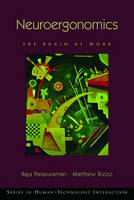
Neuroergonomics
Oxford University Press Inc (Verlag)
978-0-19-517761-9 (ISBN)
- Titel ist leider vergriffen;
keine Neuauflage - Artikel merken
Neuroergonomics can be defined as the study of brain and behaviour at work. It combines two disciplines - neuroscience, the study of brain function, and human factors, the study of how to match technology with the capabilities and limitations of people so they can work effectively and safely. The goal of merging these two fields is to use the startling discoveries of human brain and physiological functioning both to inform the design of technologies in the workplace and home, and to provide new training methods that enhance performance, expand capabilities, and optimise the fit between people and technology. Research in the area of neuroergonomics has blossomed in recent years with the emergence of noninvasive techniques for monitoring human brain function that can be used to study various aspects of human behaviour in relation to technology and work, including mental workload, visual attention, working memory, motor control, human-automation interaction, and adaptive automation. This volume provides the first systematic overview of this emerging area, describing the theoretical background, basic research, major methods, as well as the new and future areas of application.This collection will benefit a number of readers: the experienced researcher investigating related questions in human factors and cognitive neuroscience, the student wishing to get a rapid but systematic overview of the field, and the designer interested in novel approaches and new ideas for application.
Raja Parasuraman is Professor of Psychology at George Mason University. He has longstanding research programs in human factors and cognitive neuroscience. His previous books include Varieties of Attention (1984), Automation and Human Performance (1996), and The Attentive Brain (1998). In 2004 he received the Franklin V. Taylor Award for Lifetime Achievement in Applied Experimental and Engineering Psychology from the American Psychological Association. From 2001 to 2005, he served as Chair of the National Research Council's Committee on Human Factors in the National Academy of Sciences. Matt Rizzo is Professor of Neurology, Engineering, and Public Policy at the University of Iowa, where he directs the Division of Neuroergonomics and is a senior member of the Division of Behavioral Neurology and Cognitive Neuroscience. He is also a Development Executive and Science Advisor at a New York-based media company producing documentaries for major television venues. Dr. Rizzo has longstanding research support through the National Institutes of Health and the Centers for Disease Control and Prevention. He has contributed to many scholarly papers and books, served on numerous professional committees, and is a member of several professional organizations.
PART I: INTRODUCTION; 1. Introduction to Neuroergonomics; PART II: NEUROERGONOMICS METHODS; 2. Electrocephalography (EEG) in Neuroergonomics; 3. Event-related Potentials (ERPs) in Neuroergonomics; 4. Functional Magnetic Resonance Imaging (fMRI): Advanced Methods and Applications to Driving; 5. Optical Imaging of Brain Function; 6. Transcranial Doppler Sonography; 7. Eye Movements as a Window on Perception and Cognition; 8. The Brain in the Wild: Tracking Human Behavior in Natural and Naturalistic Settings; PART III: PERCEPTION, COGNITION, AND EMOTION; 9. Spatial Navigation; 10. Cerebral blood flow and vigilance; 11. Executive Functions; 12. The Neurology of Emotions and Feelings, and Their Role in Behavioral Decisions; PART IV: STRESS, FATIGUE, AND PHYSICAL WORK; 13. Stress and Neuroergonomics; 14. Sleep and Circadian Control of Neurobehavioral Function; 15. Physical Neuroergonomics; PART V: TECHNOLOGY APPLICATIONS; 16. Adaptive Automation; 17. Virtual Reality and Neuroergonomics; 18. The Role of Emotion-inspired Abilities in Relational Robots; PART VI: SPECIAL POPULATIONS; 20. EEG Brain-computer Interface; 21. Artificial Vision; 22. Neurorehabilitation-robotics and Neuroprosthetics; 23. Medical Safety and Neuroergonomics; PART VII: CONCLUSIONS; 24. Future Prospects for Neuroergonomics
| Erscheint lt. Verlag | 16.11.2006 |
|---|---|
| Zusatzinfo | 28 colour and 80 black & white illustrations |
| Verlagsort | New York |
| Sprache | englisch |
| Themenwelt | Geisteswissenschaften ► Psychologie ► Allgemeine Psychologie |
| Geisteswissenschaften ► Psychologie ► Biopsychologie / Neurowissenschaften | |
| Geisteswissenschaften ► Psychologie ► Verhaltenstherapie | |
| Mathematik / Informatik ► Informatik ► Theorie / Studium | |
| Naturwissenschaften ► Biologie ► Humanbiologie | |
| Naturwissenschaften ► Biologie ► Zoologie | |
| Technik | |
| ISBN-10 | 0-19-517761-4 / 0195177614 |
| ISBN-13 | 978-0-19-517761-9 / 9780195177619 |
| Zustand | Neuware |
| Informationen gemäß Produktsicherheitsverordnung (GPSR) | |
| Haben Sie eine Frage zum Produkt? |
aus dem Bereich


